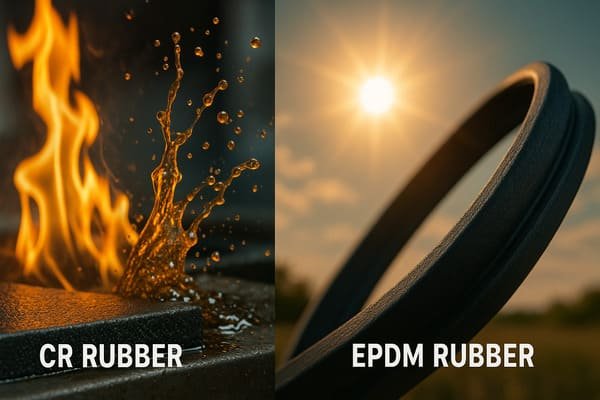Are you choosing between CR (Chloroprene Rubber) and EPDM (Ethylene Propylene Diene Monomer) for your application? Understanding the differences in properties, resistance, and suitable uses can help you determine which material is more suitable for your needs. Let’s compare CR and EPDM to make an informed decision.
CR and EPDM are both versatile synthetic rubbers, but CR offers better resistance to oil, weathering, and fire, while EPDM excels in ozone, UV, and temperature resistance.

CR and EPDM each have unique properties that make them suitable for different applications. Let’s dive into their individual characteristics and see which material is best for your specific needs.
What Is CR (Chloroprene Rubber)?
CR, or Chloroprene Rubber1, also known as Neoprene, is a synthetic rubber known for its excellent resistance to oils, weathering, and heat. Let’s explore CR rubber in more detail and understand where it excels.
CR is highly resistant to oils, heat, and weathering, making it ideal for automotive, industrial, and outdoor applications.
Chloroprene Rubber (CR), or Neoprene, is a synthetic rubber produced by polymerizing chloroprene. It is known for the following key properties:
- Chemical Resistance: CR is highly resistant to oils, fuels, and chemicals, making it a popular choice for automotive seals, gaskets, and hoses.
- Weather and UV Resistance: CR offers excellent protection against UV light, ozone, and weathering, making it suitable for outdoor applications such as roofing materials and weatherstripping.
- Heat Resistance: CR can withstand higher temperatures compared to many other rubber types, offering stability in high-temperature environments.
- Flame Resistance: CR has inherent flame resistance, which is beneficial in applications requiring fire protection, such as fire-resistant gloves or coatings.
Common applications of CR include automotive seals, HVAC gaskets, roofing materials, medical devices, and wetsuits.
What Is EPDM (Ethylene Propylene Diene Monomer) Rubber?
EPDM, or Ethylene Propylene Diene Monomer2, is another type of synthetic rubber known for its excellent ozone, UV, and weather resistance. Let’s take a closer look at EPDM and its properties.
EPDM is highly resistant to ozone, UV radiation, and extreme temperatures, making it ideal for outdoor applications like seals, gaskets, and roofing materials.
EPDM is a synthetic rubber made from the polymerization of ethylene, propylene, and a diene monomer. It is known for its superior resistance to the following:
- Ozone and UV Resistance: EPDM excels in environments where exposure to sunlight, UV rays, and ozone is a concern. It is commonly used in outdoor applications like roofing materials and weather seals.
- Temperature Resistance: EPDM can withstand a wide range of temperatures, from -40°C to +150°C, without significant degradation.
- Chemical Resistance: While EPDM does not perform as well in oil and fuel resistance3 as CR, it offers excellent resistance to water, steam, and some chemicals, making it ideal for use in hose and gasket applications.
- Weatherability: EPDM is one of the best materials for long-term weather resistance4, making it suitable for use in harsh outdoor conditions.
EPDM is commonly used in automotive parts, roofing materials, seals, gaskets, and plumbing systems.
What Are the Key Differences Between CR and EPDM Rubber?
So, what exactly distinguishes CR from EPDM rubber? Let’s break down the key differences between these two materials based on their properties and applications.
CR and EPDM differ mainly in their resistance to oil, heat, and weathering. CR excels in oil and fuel resistance, while EPDM outperforms CR in ozone and UV resistance.

Here’s a comparison of the key differences between CR and EPDM rubber:
| Property | CR Rubber | EPDM Rubber |
|---|---|---|
| Resistance to Heat | Good resistance to heat, but not as high as EPDM. | Excellent heat resistance, up to +150°C. |
| Oil and Fuel Resistance | Excellent resistance to oils and fuels. | Poor oil and fuel resistance. |
| Ozone and UV Resistance5 | Good resistance to ozone and UV, but lower than EPDM. | Superior resistance to ozone, UV, and weathering. |
| Weather Resistance | Good weathering resistance. | Excellent weathering and environmental resistance. |
| Chemical Resistance | Good resistance to oils, fuels, and chemicals. | Moderate chemical resistance6, especially in water and steam. |
| Flame Resistance | Inherent flame resistance7. | No significant flame resistance. |
| Common Applications | Automotive, industrial seals, medical devices, wetsuits. | Automotive, roofing, weather seals, plumbing systems. |
As shown in the table, CR is the better choice for applications requiring oil and fuel resistance, while EPDM excels in outdoor applications where UV and ozone resistance are critical.
What Are the Best Applications for CR and EPDM?
Now that we know the differences, which rubber is best for your application? Let’s take a look at where CR and EPDM perform best.
CR is ideal for oil and fuel-related applications, while EPDM is better suited for outdoor, UV-exposed, and high-temperature applications.

Best Uses for CR (Chloroprene Rubber):
- Automotive: CR is widely used for fuel lines, seals, gaskets, and hoses that require excellent resistance to oils and fuels.
- Industrial: CR is also used in industrial applications where chemical resistance is required, such as in industrial seals and gaskets.
- Medical: CR’s flame resistance and biocompatibility make it a choice material for medical devices like gloves, catheters, and masks.
Best Uses for EPDM (Ethylene Propylene Diene Monomer):
- Automotive: EPDM is commonly used for weatherstripping, seals, and gaskets in automotive parts due to its resistance to UV and ozone.
- Construction: EPDM is often used in roofing materials and outdoor seals due to its excellent weathering resistance and UV stability.
- Plumbing: EPDM is used in hose and gasket applications where exposure to water and steam is common.
Conclusion
Choosing between CR and EPDM depends largely on your specific application needs. CR is ideal for applications requiring oil, fuel, and chemical resistance, while EPDM is best for applications exposed to UV light, ozone, and extreme weather conditions. By understanding these differences, you can make an informed decision based on your material needs.
🚀 Need Custom Rubber Solutions for Your Specific Application?
Contact Julong Rubber today or Request a Custom Quote for high-quality CR and EPDM products tailored to your needs!
Or reach out to us directly via WhatsApp:

Explore the advantages of Chloroprene Rubber for industrial uses, including its chemical resistance and durability. ↩
Learn how Ethylene Propylene Diene Monomer is utilized in construction for its weather resistance and durability. ↩
Discover the significance of oil and fuel resistance in rubber materials for automotive and industrial applications. ↩
Understanding weather resistance helps in selecting the right materials for outdoor applications, ensuring durability and longevity. ↩
Exploring this topic reveals how these resistances enhance the performance and lifespan of rubber products in harsh environments. ↩
Exploring chemical resistance will guide you in selecting the best rubber for applications involving oils, fuels, and chemicals. ↩
Learning about flame resistance is crucial for safety in applications like medical devices and automotive parts. ↩







